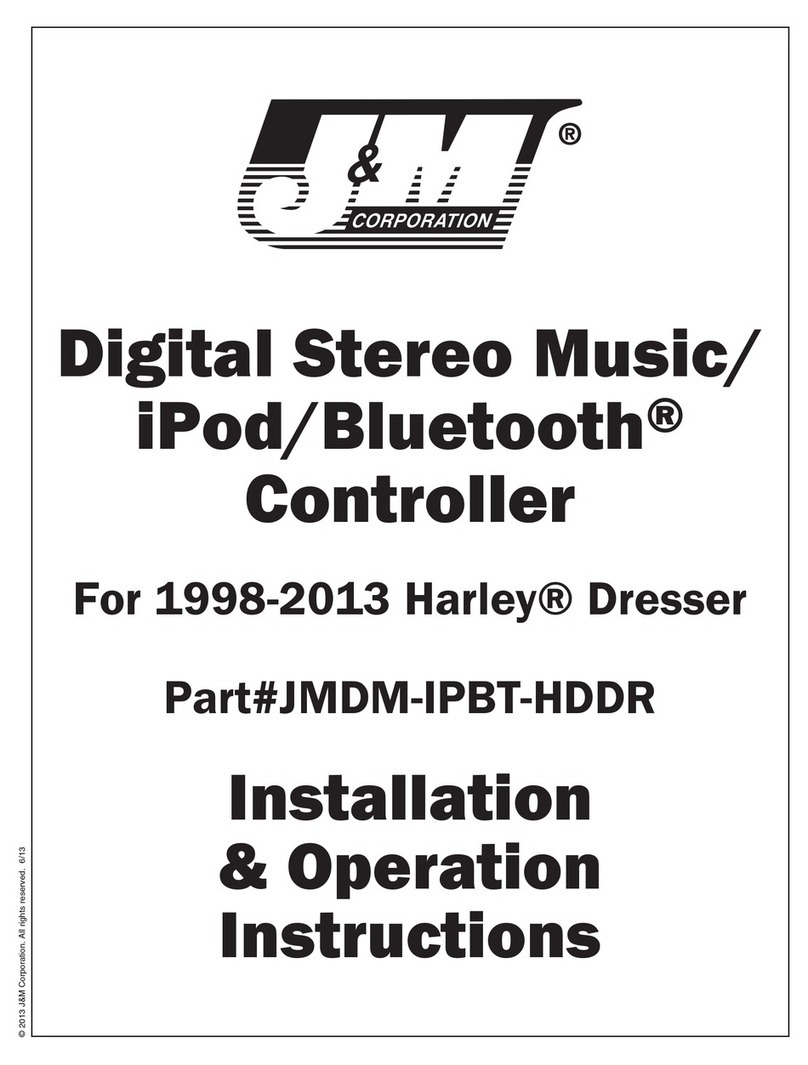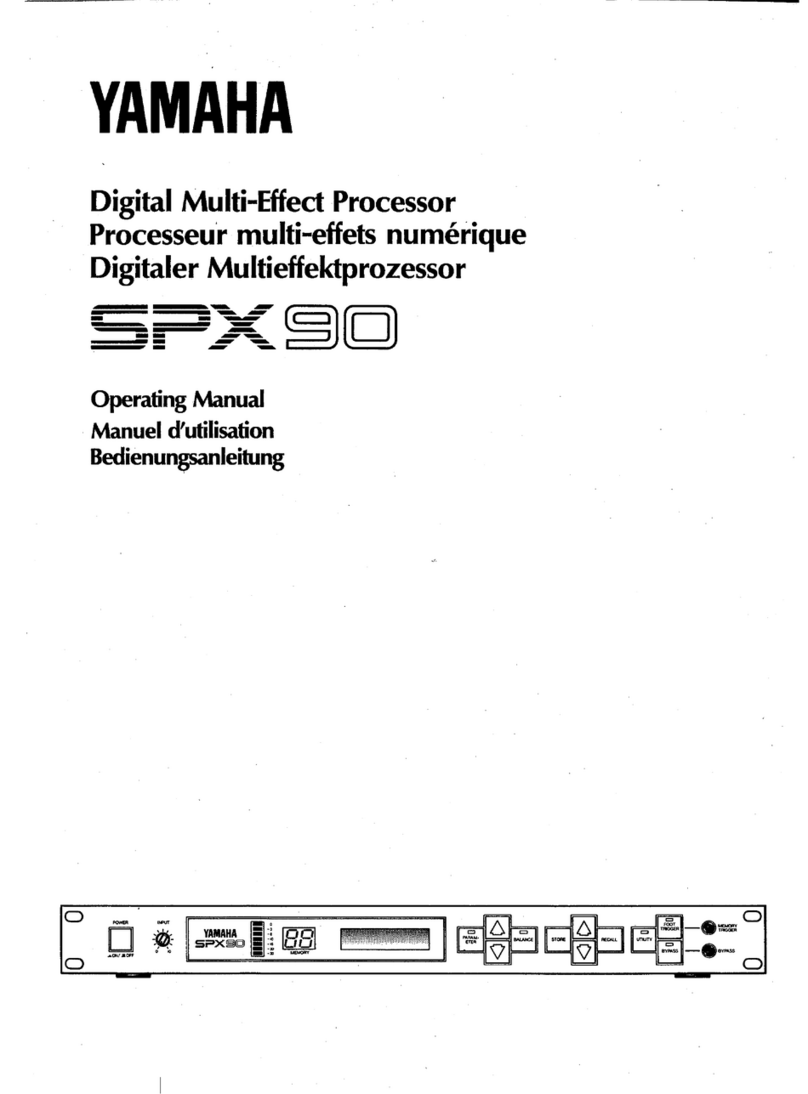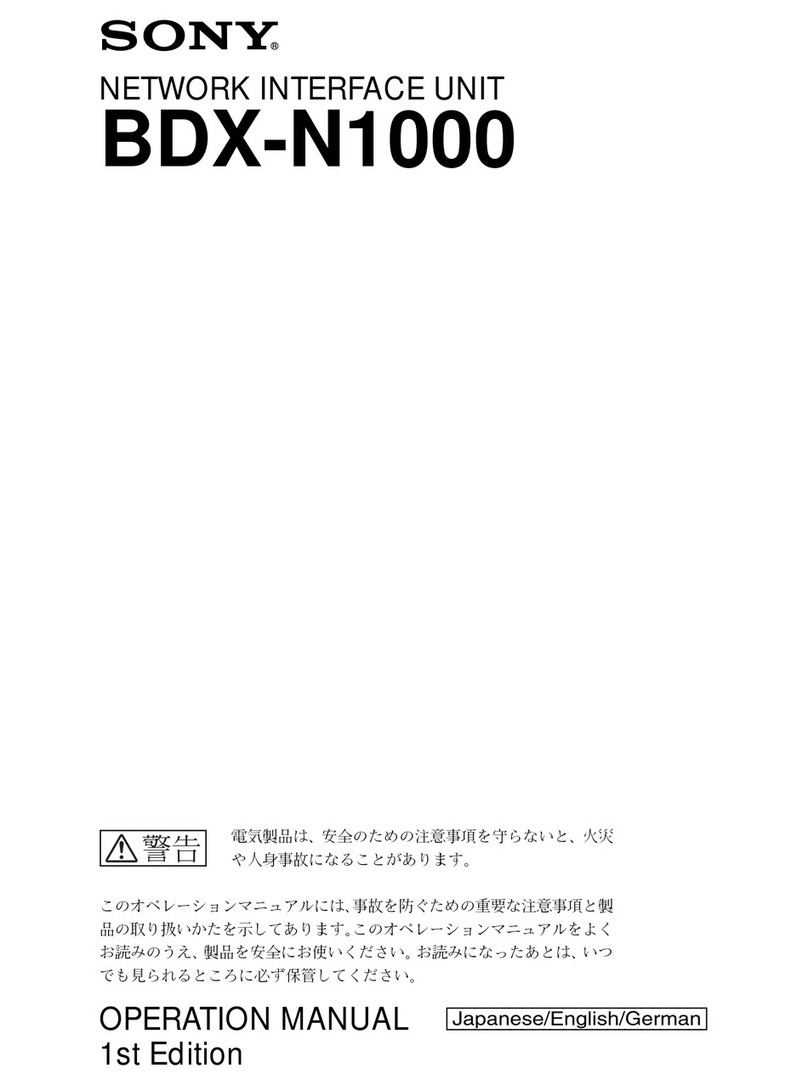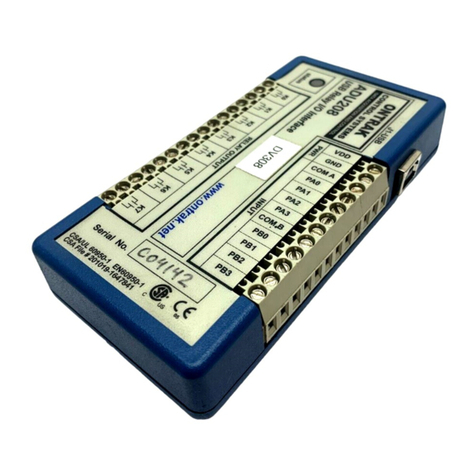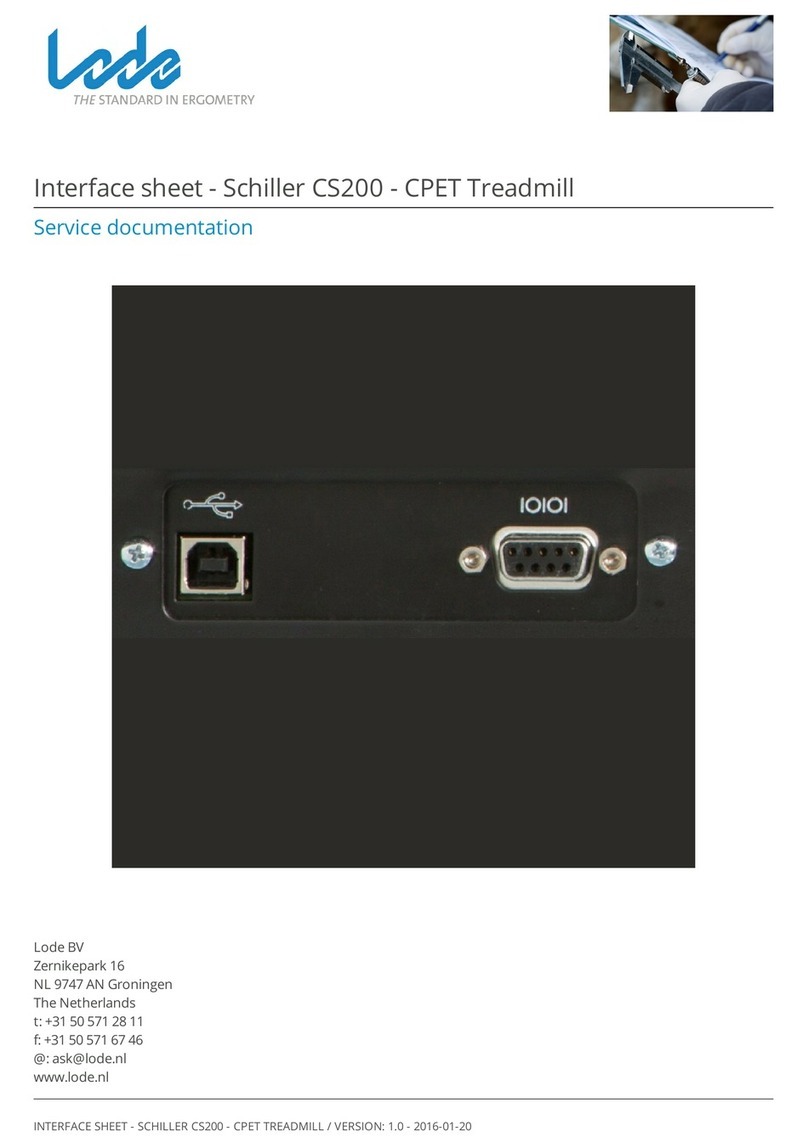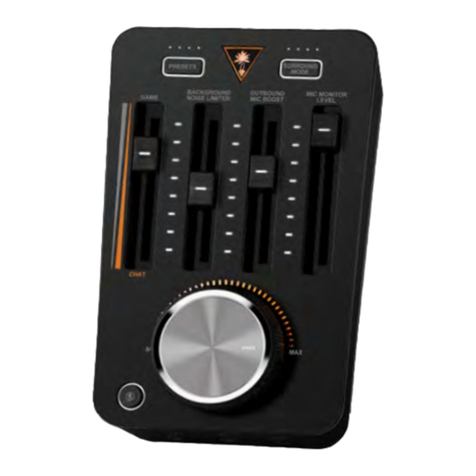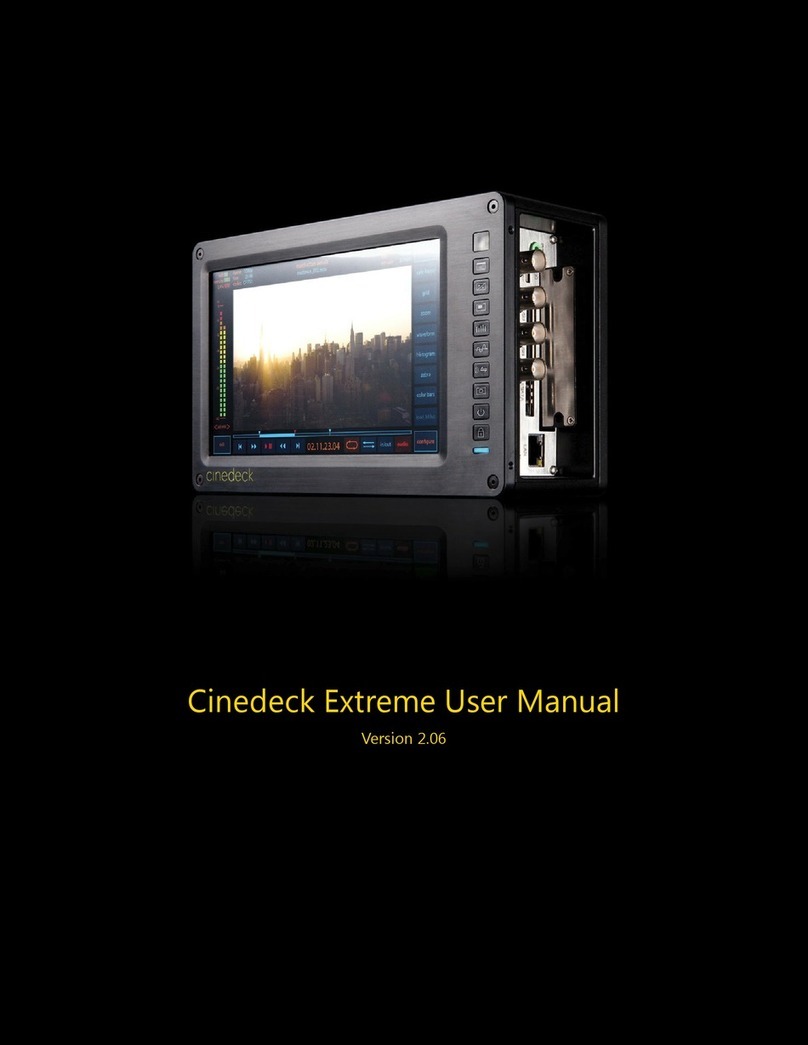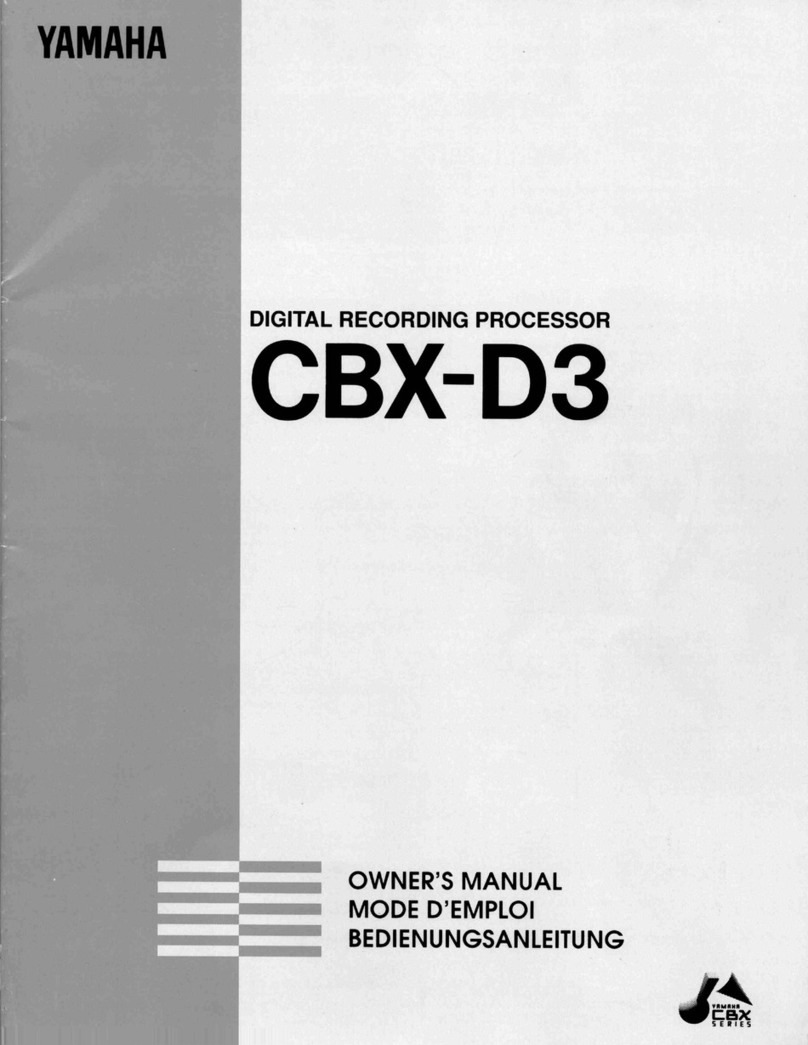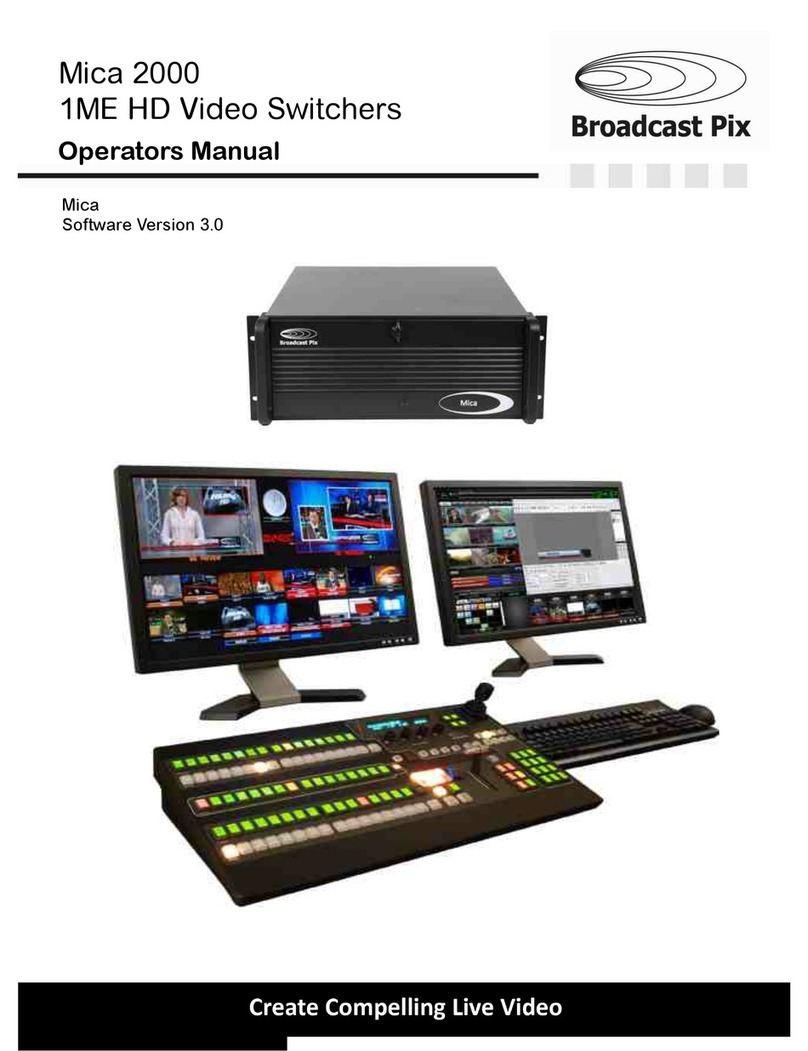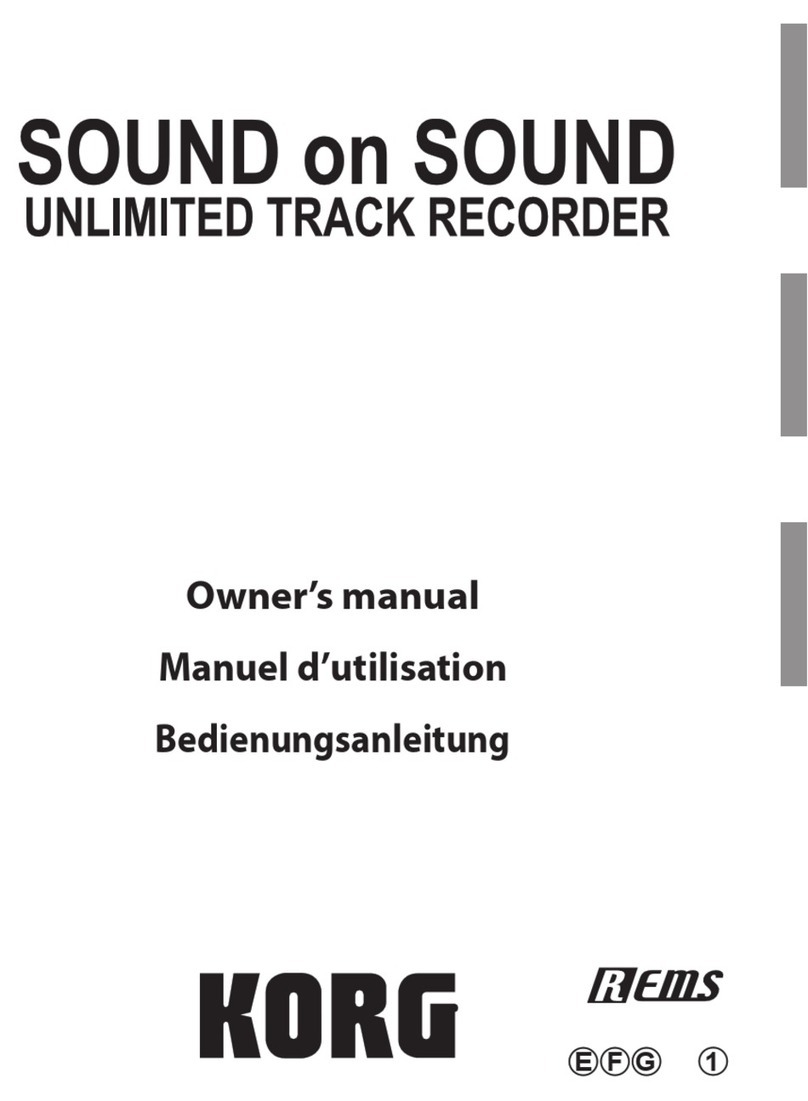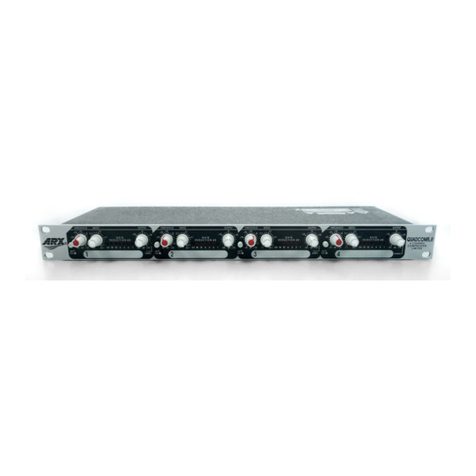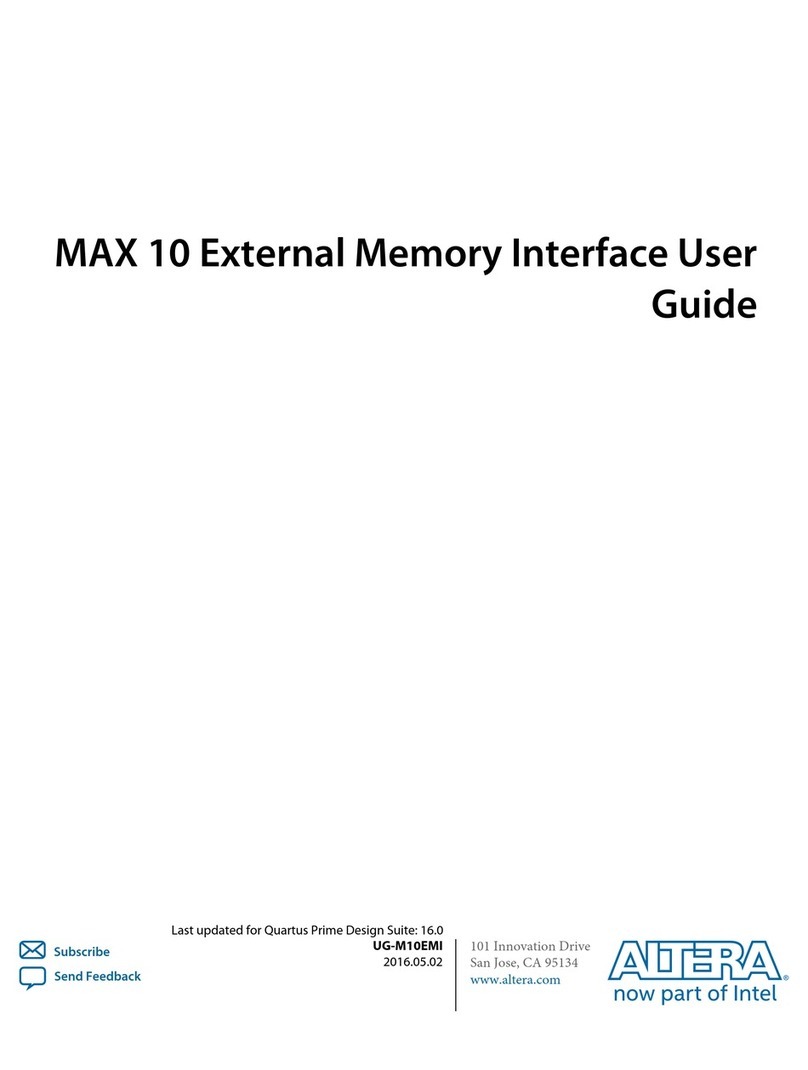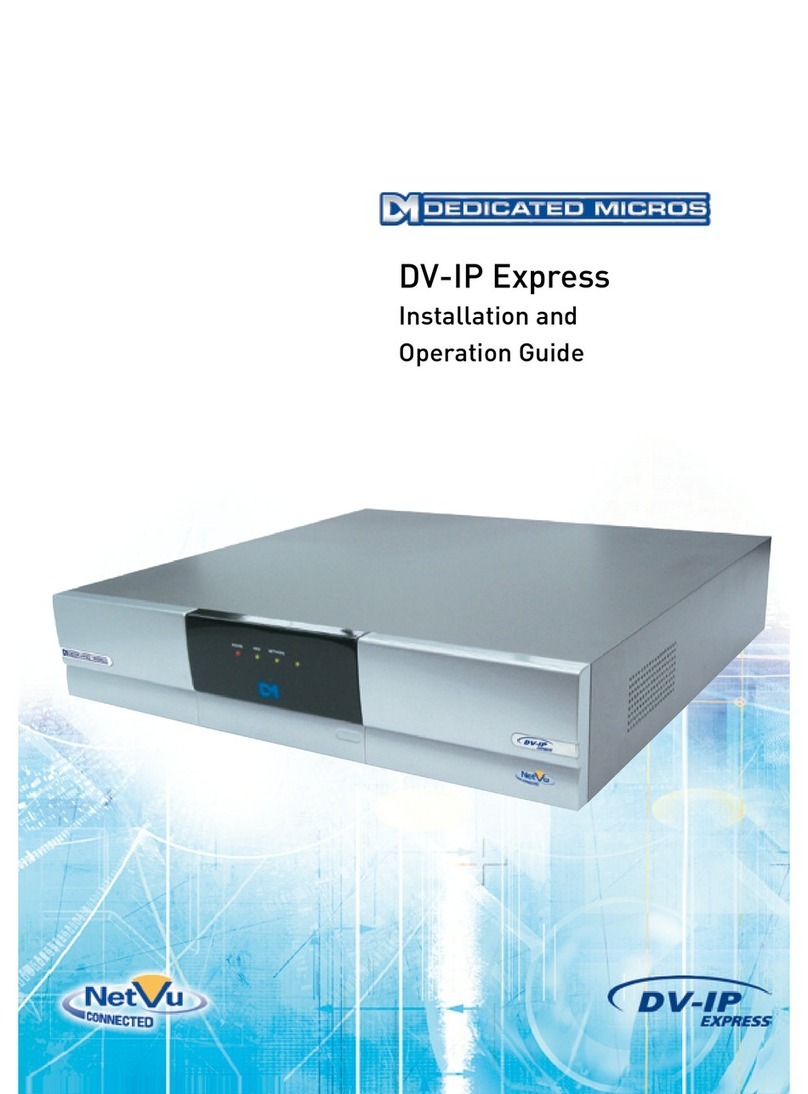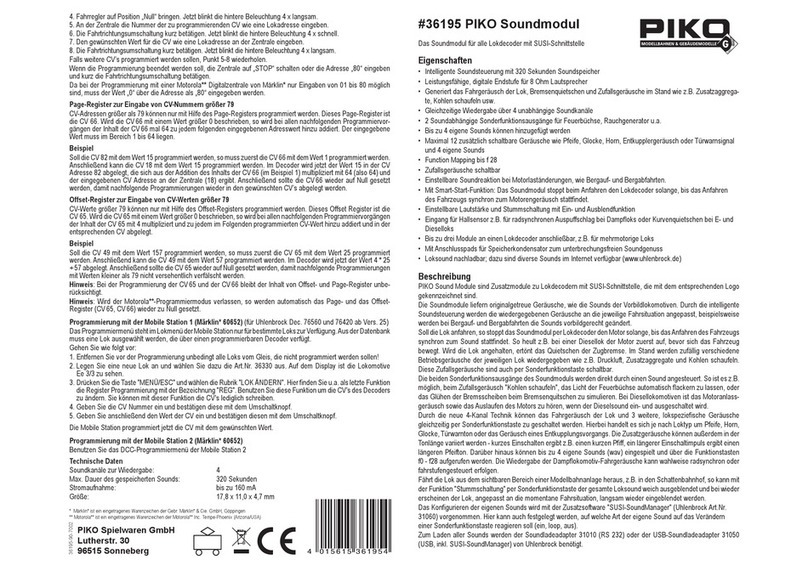MediaMatrix NOIN Dante User manual

NION Dante Hardware Manual
Version 2.0.0.0
July 7, 2017

ii Version 2.0.0.0 July 7, 2017
Copyright notice
The information contained in this manual is subject to change without notice. Peavey Electronics is not liable for
improper installation or configuration. The information contained herein is intended only as an aid to qualified
personnel in the design, installation and maintenance of engineered audio systems. The installing contractor or end
user is ultimately responsible for the successful implementation of these systems.
All creative content in this manual, including the layout, art design, content, photography, drawings, specifications
and all other intellectual property is Copyright © 2016 Peavey Electronics Corporation. All Rights Reserved. Features
& specifications subject to change without notice. All other registered trademarks or trademarks are the property of
their respective owners.
Scope
This guide describes how to physically install a NION and configure it with basic settings.
Once you have completed the installation, we recommend that you refer to the NWare User Guide to see how to design
an audio solution and download settings to the NION.

July 7, 2017 Version 2.0.0.0 iii
Contents
Chapter 1 Important safety instructions................................................................1
Safety warnings........................................................................................................................................2
Chapter 2 Before you start .....................................................................................5
Important network considerations ............................................................................................................6
Power outage and surge protection .........................................................................................................6
Thank You! ...............................................................................................................................................6
Warranty Registration...............................................................................................................................6
What's in the box?....................................................................................................................................6
Chapter 3 Introduction to NION ............................................................................7
Description................................................................................................................................................8
Features....................................................................................................................................................8
Applications ..............................................................................................................................................9
Cards......................................................................................................................................................10
Front Panel.............................................................................................................................................12
Rear panel..............................................................................................................................................13
Network services ....................................................................................................................................14
Chapter 4 Installing the NION..............................................................................15
Introduction.............................................................................................................................................16
What you will need .................................................................................................................................16
Test configuration...................................................................................................................................17
Configuring your PC for connecting to a NION nE.................................................................................17
Connections............................................................................................................................................18
Chapter 5 Setting up the NION............................................................................23
Configuration steps.................................................................................................................................24
Using the front panel ..............................................................................................................................25
Using the web interface..........................................................................................................................33
Updating the firmware ............................................................................................................................47
Using XDAB to share DSP resources ....................................................................................................47
What to do next ......................................................................................................................................48
Appendix A Troubleshooting ...............................................................................49
Cannot access NION using IP address or IP address is unknown........................................................50
Front panel LED indicators.....................................................................................................................52
Including debug messages in the log.....................................................................................................53
Low voltage warning...............................................................................................................................54
NION locking up or rebooting spuriously................................................................................................54
Appendix B Connector ports ...............................................................................57
GPIO overview .......................................................................................................................................58
Serial communications ...........................................................................................................................62

iv Version 2.0.0.0 July 7, 2017
Appendix C Technical specifications.................................................................67
Rear panel connections..........................................................................................................................68
Digital audio performance.......................................................................................................................69
AES card DIP switches...........................................................................................................................70
XDAB performance (NION n3, NION n6)...............................................................................................71
Dante performance.................................................................................................................................72
GPIO.......................................................................................................................................................72
Mechanical specifications.......................................................................................................................72
Appendix D Reference Information ....................................................................73
Architect's and engineer's specifications................................................................................................74
Technical Support...................................................................................................................................75
Warranty statement.................................................................................................77

Chapter 1 - Important safety instructions
2 Version 2.0.0.0 July 7, 2017
.
Safety warnings
Warning: When using electrical products, basic cautions should always be followed,
including the following:
1. Read these instructions.
2. Keep these instructions.
3. Heed all warnings.
4. Follow all instructions.
5. Do not use this apparatus near water.
6. Clean only with a dry cloth.
7. Do not block any of the ventilation openings. Install in accordance with manufacturer’s
instructions.
8. Do not install near any heat sources such as radiators, heat registers, stoves or other
apparatus (including amplifiers) that produce heat.
9. Do not defeat the safety purpose of the polarized or grounding-type plug. A polarized plug
has two blades with one wider than the other. A grounding type plug has two blades and a
third grounding plug. The wide blade or third prong is provided for your safety. If the
provided plug does not fit into your outlet, consult an electrician for replacement of the
obsolete outlet.
10. Protect the power cord from being walked on or pinched, particularly at plugs,
convenience receptacles, and the point they exit from the apparatus.
11. Only use attachments/accessories provided by the manufacturer.
12. Use only with a cart, stand, tripod, bracket, or table specified by the manufacturer, or sold
with the apparatus. When a cart is used, use caution when moving the cart/apparatus
combination to avoid injury from tip-over.
13. Unplug this apparatus during lightning storms or when unused for long periods of time.
14. Refer all servicing to qualified service personnel. Servicing is required when the apparatus
has been damaged in any way, such as power-supply cord or plug is damaged, liquid has
been spilled or objects have fallen into the apparatus, the apparatus has been exposed to
rain or moisture, does not operate normally, or has been dropped.
15. Never break off the ground pin. Write for our free booklet Shock Hazard and Grounding.
Connect only to a power supply of the type marked on the unit adjacent to the power
supply cord.
16. If this product is to be mounted in an equipment rack, rear support should be provided.
17. Control panel devices, including the xControl range, D series and nTouch 60, are designed
for mounting in NEMA metal enclosures. Grounding to the front plate is required.
18. Note for UK only: If the colors of the wires in the mains lead of this unit do not
correspond with the terminals in your plug‚ proceed as follows:
a) The wire that is colored green and yellow must be connected to the terminal that is
marked by the letter E‚ the earth symbol‚
b) colored green or colored green and yellow.
c) The wire that is colored blue must be connected to the terminal that is marked with the
letter N or the color black.

NION Dante Hardware Manual
July 7, 2017 Version 2.0.0.0 3
d) The wire that is colored brown must be connected to the terminal that is marked with
the letter L or the color red.
19. This electrical apparatus should not be exposed to dripping or splashing and care should be
taken not to place objects containing liquids, such as vases, upon the apparatus.
20. The on/off switch in this unit does not break both sides of the primary mains. Hazardous
energy can be present inside the chassis when the on/off switch is in the off position. The
mains plug or appliance coupler is used as the disconnect device, the disconnect device
shall remain readily operable.
21. Exposure to extremely high noise levels may cause a permanent hearing loss. Individuals
vary considerably in susceptibility to noise-induced hearing loss, but nearly everyone will
lose some hearing if exposed to sufficiently intense noise for a sufficient time. The U.S.
Government’s Occupational Safety and Health Administration (OSHA) has specified the
following permissible noise level exposures:
Duration Per Day in Hours
Sound Level dBA, Slow
Response
8
90
6
92
4
95
3
97
2
100
1½
102
1
105
½
110
¼ or less
115
According to OSHA, any exposure in excess of the above permissible limits could result in
some hearing loss. Ear plugs or protectors to the ear canals or over the ears must be worn when
operating this amplification system in order to prevent a permanent hearing loss, if exposure is
in excess of the limits as set forth above. To ensure against potentially dangerous exposure to
high sound pressure levels, it is recommended that all persons exposed to equipment capable
of producing high sound pressure levels such as this amplification system be protected by
hearing protectors while this unit is in operation.
SAVE THESE INSTRUCTIONS!


July 7, 2017 Version 2.0.0.0 5
In This Chapter
Important network considerations.....................................................................6
Power outage and surge protection...................................................................6
Thank You!.......................................................................................................6
Warranty Registration.......................................................................................6
What's in the box?.............................................................................................6
Chapter 2
Before you start

Chapter 2 - Before you start
6 Version 2.0.0.0 July 7, 2017
.
Important network considerations
This product is designed to operate on a network backbone or infrastructure. The
design, implementation and maintenance of this infrastructure is critical to correct
operation and performance of the product. Peavey Electronics Corp does not support
nor service network cabling, hubs, switches, patch bays, wall plates, connector
panels or any other type of network interconnect device. Please ensure that these
components and their associated installation techniques have been properly
designed and installed for audio and network applications.
Power outage and surge protection
We make the following recommendations for the power source:
Use an uninterruptable power supply (UPS) to protect against power outages.
Use a power surge protection device, such as a Surge-X (http://www.surgex.com). This
provides protection from destructive spikes, surges and inductive transients.
Thank You!
Thank you for purchasing this MediaMatrix product. It is designed to provide years of
trouble-free operation and high quality performance. We are confident that you will find this
product and other MediaMatrix products to be of the highest quality.
Warranty Registration
Please take afew minutes and fill out the warranty registration card. Although your warrantyis
valid without the registration, the information you provide with the form is crucial to our
support group. It enables us to provide better service and customer support, and to keep you
informed of new product updates.
Tip: Refer to the warranty statement at the rear of this manual for details of what your
warranty includes and what the limitations are.
What's in the box?
NION series products are packaged ina single container. This container includes the following
items:
NION n6, NION n3, NION nX or NION nE Network Input/Output Node
IEC removable power supply cable (120 VAC domestic)
Shielded CAT 6 cable, 1’
Software installation CD
User manual/literature package.
If any of these items are missing, please contact your Authorized Peavey MediaMatrix
contractor/dealer.

July 7, 2017 Version 2.0.0.0 7
In This Chapter
Description........................................................................................................8
Features.............................................................................................................8
Applications......................................................................................................9
Cards.................................................................................................................10
Front Panel........................................................................................................12
Rear panel .........................................................................................................13
Network services...............................................................................................14
Chapter 3
Introduction to NION

Chapter 3 - Introduction to NION
8 Version 2.0.0.0 July 7, 2017
.
Description
NION is a programmable digital audio processing node designed for professional and
commercial audio and communications applications.
The product features an internal processing core supported by a wide range of features,
including a scalable I/O architecture. A range of plug-in cards is available that allow audio
input and output, plus advanced features like echo cancellation.
Audio network connectivity is provided by the integrated Dante DLM module.
NIONs are managed centrally using NWare. You can also specify configuration settings using
the web interface or front panel interface (fitted to all models apart from the nE).
Additional control interfacing is provided by both RS-232 and RS-422/485 ports, while a
configurable GPIO system allows interfacing with hard contacts and logic systems.
Note: If you are intending to use a NION to host a Kiosk2Go project, it is important that the
compact flash (CF) memory card is of sufficient capacity. If the NION is fitted with a 256MB
card, you may find problems with the display of more complex Kiosk2Go projects in the
browser. We recommend that the compact flash card is replaced with a higher capacity
version. To check the capacity of the CF memory card, navigate to the NION web interface,
then click Hardware. The capacity is displayed under Memory, as CFA: xxx meg. For more
Features
Floating point DSP Engine with 6 DSP
chips (NION n6) or 3 DSP chips (NION
n3, NION nX and NION nE)
Front panel interface with intuitive user
input controls (n3, n6 and nX models
only)
World-famous MediaMatrix audio
algorithms
Robust Linux embedded system
controller
64 channels of audio I/O via integrated
Dante interface.
Integrated flash-based storage
32 channels of audio I/O via 8 four
channel cards.
Supports optional hard-disk storage
systems
32 bit processing engine
Windows configuration and control client
24 bit conversion
Full support for SNMP network
management tools
XDAB bus (NION n3, NION n6)
supports up to 448 bi-directional audio
channels
Universal industrial-grade power supply
Low latency audio performance
Software support for large-scale
multi-node systems
Network-centric architecture
Advanced DSP compiler
Supports centralized, distributed or
hybrid processing
Configurable GPIO with DIN rail
package
Integrated serial support
Transparent control grouping across

NION Dante Hardware Manual
July 7, 2017 Version 2.0.0.0 9
physical nodes
Supports sample rates of 48 kHz and 96
kHz
Supports redundant, self-healing
configurations
Standalone or combined operation
Applications
Stadiums
Auditoriums
Arenas
Civic centers
Performing arts centers
Theaters
Courts of law
Houses of worship
Campus buildings
Theme parks
Hotel meeting rooms
Conference centers
Schools
Cruise ships
Teleconferencing
Distance learning
Large-scale paging
Multi-purpose facilities
Retail
Restaurants & bars
Gaming
Institutional paging
Communications
Correctional facilities
Professional complexes
Residential.

Chapter 3 - Introduction to NION
10 Version 2.0.0.0 July 7, 2017
.
Cards
All the different types of cards can be installed in any of the available expansion slots at the
rear of the NION.
NIO-4x4
Four analog mic/line level audio input channels
Four analog line level audio output channels
24 bit A/D (inputs), 24 bit D/A (outputs)
48 or 96 kHz audio sampling rate supported
High reliability DIN connector to backplane, using slide rail for alignment
Mini-Euro connectors for easy input connection.
NIO-8ml II
Eight analog mic/line level audio input channels
24 bit A/D (inputs)
48 or 96 kHz audio sampling rate supported
High reliability DIN connector to backplane, using slide rail for alignment
Mini-Euro connectors for easy input connection.
NIO-8i
Eight analog line level audio input channels
24 bit A/D (inputs)
48 or 96 kHz audio sampling rate supported
High reliability DIN connector to backplane, using slide rail for alignment
Mini-Euro connectors for easy input connection.
NIO-8o
Eight analog line level audio output channels
24 bit A/D (outputs)
48 or 96 kHz audio sampling rate supported
High reliability DIN connector to backplane, using slide rail for alignment
Mini-Euro connectors for easy input connection.
NIO-AEC
Eight analog mic/line-level audio input channels with 24 bit A/D
Eight channels of wideband acoustic echo cancellation
Acoustic echo cancellation can be applied to mic input or internal audio input channels
(from NION)
48 or 96 kHz audio sampling rate supported

NION Dante Hardware Manual
July 7, 2017 Version 2.0.0.0 11
High reliability DIN connector to backplane, using slide rail for alignment
Mini-Euro connectors for easy input connection.
NIO-AES
Eight channel pairs of AES3 input or output audio channels
Input or output channel pairs may be selected individually in software
S/PDIF supported and enabled with onboard dip switches
Sample rate converters defeatable in the NWare control software
48 or 96 kHz audio sampling rate supported
High reliability DIN connector to backplane, using slide rail for alignment
Mini-Euro connectors for easy input connection.

Chapter 3 - Introduction to NION
12 Version 2.0.0.0 July 7, 2017
.
Front Panel
1. IDE Single-color LED indicates data transmission to or from the internal IDE storage
media.
2. LAN Single-color LED indicates data transmission to or from the Ethernet network
interface.
3. XDAB Single-color LED indicates data transmission to or from the XDAB audio
expansion bus (NION n3 and n6 only).
4. Mute/Fault Single-color LED indicates muted audio condition. When lit, the fault relay is
activated. For more information, see Fault relay (on page 58).
5. LCD Display Backlit graphical display provides access to system hardware monitoring,
configuration and status functionality. (NION n3, n6 and nX only).
6. Air Vent Air intake vent provides fresh air flow to internal cooling system.
Do not block or obstruct this vent. Proper airflow must be maintained for proper
operation.
7. ATTN Button includes a red LED that flashes when user response is required.
When pressed, the LCD screen will update to show details of the error (NION n3, n6 and
nX only).
8. Power Button will start the boot up process when in standby mode. When the unit is
running, the button will cause the LCD screen to jump directly to the Power menu, where
you can choose to Power Down or Reboot.
Note: There is an intentional delay after powering off and before the Power button will
turn on the unit. This is meant to protect the circuitry by allowing voltages to fully
discharge. The integrated LED will not illuminate.
9. Soft Buttons (4). Momentary buttons used in conjunction with the LCD display allow
user input and navigation of hardware functionality. The function of each button is
indicated on the display text of the LCD display graphic nearest the corresponding button.
The integrated LEDs will not illuminate (NION n3, n6 and nX only).
10. Data Wheel Continuous action rotary encoder and embedded push-button provide
navigation and data entry functionality in conjunction with the LCD display. The function
of these controls is dependent on the active function of the LCD display (NION n3, n6 and
nX only).

NION Dante Hardware Manual
July 7, 2017 Version 2.0.0.0 13
Rear panel
1. Serial Port Female DB-9 panel connector, which provides RS-232 communications for
external control protocols.
Note: On earlier units, this connector is on the front panel.
2. Power Receptacle Flush-mount IEC power receptacle for connecting a compatible IEC
power cable (included).
Use only the supplied cable or an equivalent international version.
3. Module Bays Housingbays for NION series expansion cards. Up to 4 Nio series I/O cards
can be installed.
4. Power Supply Industrial ATX format power supply with exhaust fan.
Additional air flow is provided on the side panel opposite the power supply. Install
with at least 2” of free clearance on sides of unit. Do not block any air intake or
exhaust vent.
5. XDAB In/Out RJ-45 connectors accept shielded CAT6 data cables for proprietary NION
interconnect system.
6. GPIO Female DB-25 panel connector provides access to the internal GPIO control
functionality.
7. LAN RJ-45 panel connector accepts a CAT5 data cable for data transport to/from the
internal network interface. This connection is required on all units for system
configuration and inter-unit communications.
8. RS-485/422 Female DB-9 panel connector accepts a standard DB-9 connector (not
included) to provide access to the external RS-485 or RS-422 external control protocols.
9. Dante network I/O ports Two RJ-45 connectors providing a primary and secondary
interface to the Dante network. One connection is required to pass audio to or from the
device. The second connection provides redundancy.

Chapter 3 - Introduction to NION
14 Version 2.0.0.0 July 7, 2017
Note: The secondary port does not provide additional network capacity and only becomes
active in the event that the network connected to the primary port becomes inoperative.
Network services
Web
Each NION includes a built-in web server that provides access to several key hardware
functions from any web browser.
Telnet
Telnet is a communications protocol that provides access to the Linux system kernel on the
NION.
Note: For security reasons, you should only enable the Telnet function when asked to by
MediaMatrix Technical Support. Once you have finished communicating with the NION, you
should disable the Telnet function. Telnet is not required for communications with the NWare
software or for using RATC.
SNMP
Simple Network Management Protocol is a network protocol that provides robust monitoring
and control of system parameters across the network. Using SNMP, you can utilize a host of
standard software tools and third-party systems to extend the control and monitoring power of
the NION for a wide variety of applications.
FTP
File Transfer Protocol. A standard network protocol used for transferring files over a TCP
network. Each NION, nControl and nTouch 180 has a built-in FTP server.

July 7, 2017 Version 2.0.0.0 15
In This Chapter
Introduction.......................................................................................................16
What you will need...........................................................................................16
Test configuration.............................................................................................17
Configuring your PC for connecting to a NION nE .........................................17
Connections.......................................................................................................18
Chapter 4
Installing the NION

Chapter 4 - Installing the NION
16 Version 2.0.0.0 July 7, 2017
.
Introduction
The NION is designed to mount in a standard EIA electronic equipment rack. Because the
NION includes forced air cooling, rack mounted vent panels are not required for most
installations. However, vent panels may be required in large installations where multiple units
are mounted in a single rack. It is generally accepted that a ratio of 2:1 usually provides
adequate performance. In installations where adverse conditions exist, and room temperatures
are likely to rise, additional vents should be installed.
This product should be installed so that its mounting position does not interfere
with proper ventilation. Do not block air intake or exhaust vents.
The power switch in this unit does not break both sides of the primary mains.
Hazardous energy can be present inside the chassis when the power switch is in the
off position. The mains plug or appliance coupler is used as the disconnect device,
the disconnect device shall remain readily operable.
What you will need
A MediaMatrix NION with Dante DLM fitted.
The latest Dante Controller software. (Updates can be downloaded from the Audinate
website (http://www.audinate.com).)
The latest NWare software. (Updates can be downloaded from the MediaMatrix website
(http://www.peaveycommercialaudio.com/products.cfm/Software/NWare-Software/NWar
e-Software).)
A computer running Microsoft Windows, with monitor, mouse and keyboard.
An assortment of CAT 5e or CAT 6 cables.
At least one NIO series analog audio input card.
At least one NIO series analog audio output card.
Tip: The NIO-4x4 card supports both analog audio inputs and outputs on the same card.
This card can be used in place of an input card and an output card.
An audio source, cables, power amplifier and loudspeaker.
A small Phillips screwdriver.
A small flat-blade screwdriver.
A network switch connected to the Dante network.
Note: Dante uses standard Voice over IP (VoIP) Quality of Service (QoS) switch features
to prioritize clock sync and audio traffic over other network traffic. QoS is available in
many inexpensive and enterprise Ethernet switches. Any switch that supports Diffserv
(DSCP) QoS with strict priority and 4 queues, and has Gigabit ports for inter-switch
connections should be appropriate for use with Dante, but we recommend that you check
the Q&A section on the Audinate website (http://www.audinate.com) for details of any
other requirements.
This manual suits for next models
1
Table of contents

